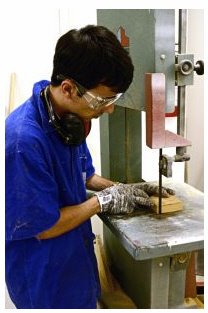Job Creation and the Unemployment Rate
by William Chiu A rise in the unemployment rate generally signals a weakening labor market and a weakening economy. A rising unemployment rate typically signals a recession. A falling unemployment rate typically signals economic expansion.
A rise in the unemployment rate generally signals a weakening labor market and a weakening economy. A rising unemployment rate typically signals a recession. A falling unemployment rate typically signals economic expansion.The Bureau of Labor Statistics (BLS) reported that the unemployment rate rose from 4.7% to 4.8% during February 2006. The BLS also reported that the economy created 243,000 new jobs during this same period. More new jobs coupled with a higher unemployment rate--what's going on? Most economists view the rise in the unemployment rate as temporary (Washington Post article). In fact, strong job growth might actually cause an increase in the unemployment rate. Understanding why requires us to look at how the BLS defines unemployment.
A person is unemployed if she is jobless AND actively sought work in the past 4 weeks. The labor force is the number of people employed plus the number of people unemployed. The unemployment rate is the number of people unemployed divided by the labor force. A person who is jobless but has NOT sought work in the past 4 weeks (because she gave up after failing to get a job), is jobless but NOT unemployed--they are not part of the labor force.
Suppose on February 1st, there are 100 people in the labor force and 5 people who are initially unemployed which implies a 5% unemployment rate. Mary, John, and William lost their jobs 4 months ago but stopped looking for work after 2 months of failed attempts. Mary, John, and William are jobless but not unemployed. The economy rebounds and 1 new job is created on February 15th. The job creation inspires Mary, John, and William to begin seeking work again on February 31st.
First, of the 5 people initially unemployed, only 4 will be unemployed because one new job was created. Second, 3 additional people who were not considered unemployed initially (Mary, John, and William) enter the labor force and are now unemployed. The new labor force equals 100 + 3 = 103 people and 4 + 3 = 7 people are unemployed which implies a 6.8% unemployment rate. Hence, the unemployment rate increases because people who were not part of the labor force enter the labor force, raising the number of unemployed people along with the size of the labor force.
1. If job creation continues in March, then would the unemployment rate increase or decrease? What if people continue entering the labor force at an unusually high rate?
2. Should jobless people who did not seek jobs in the past 4 weeks be considered unemployed?
3. Is the unemployment rate a good measure of the health of the economy?
Topics: Unemployment, Pitfalls, Job creation, Macroeconomics



0 Comments:
Post a Comment
<< Home